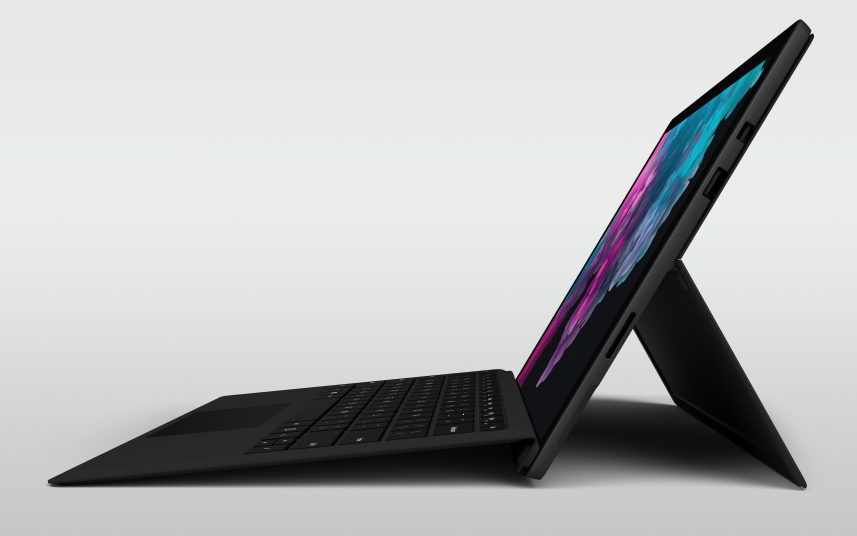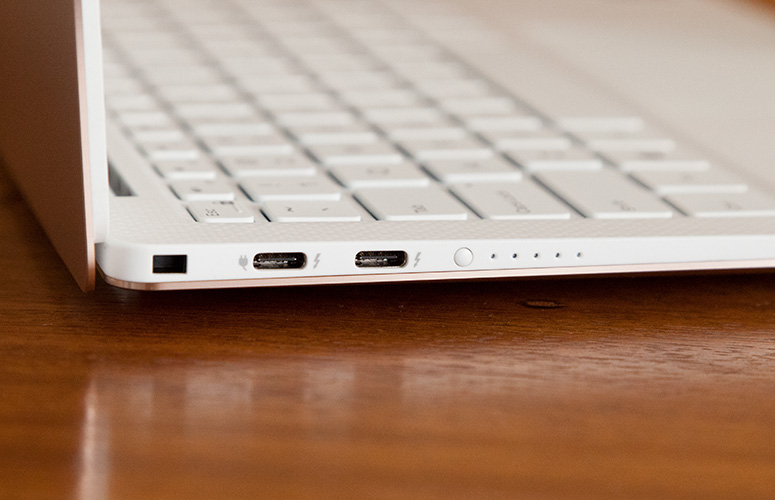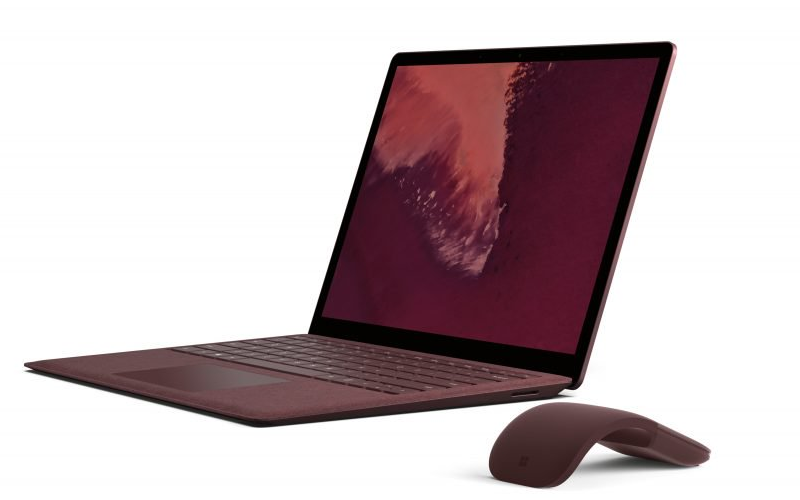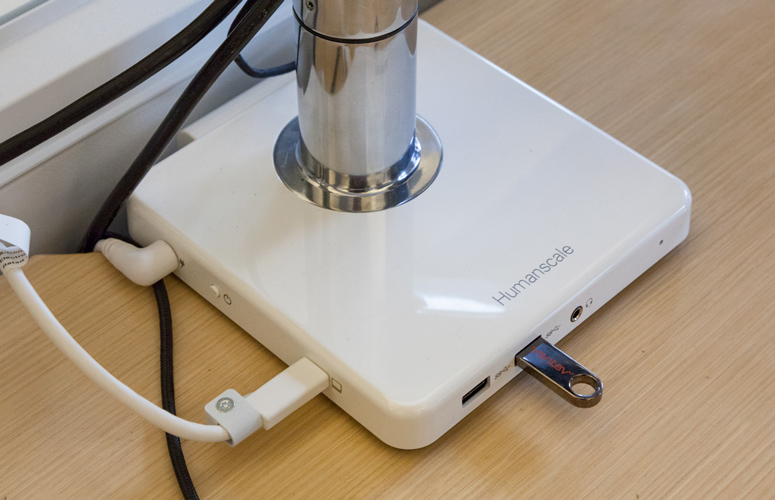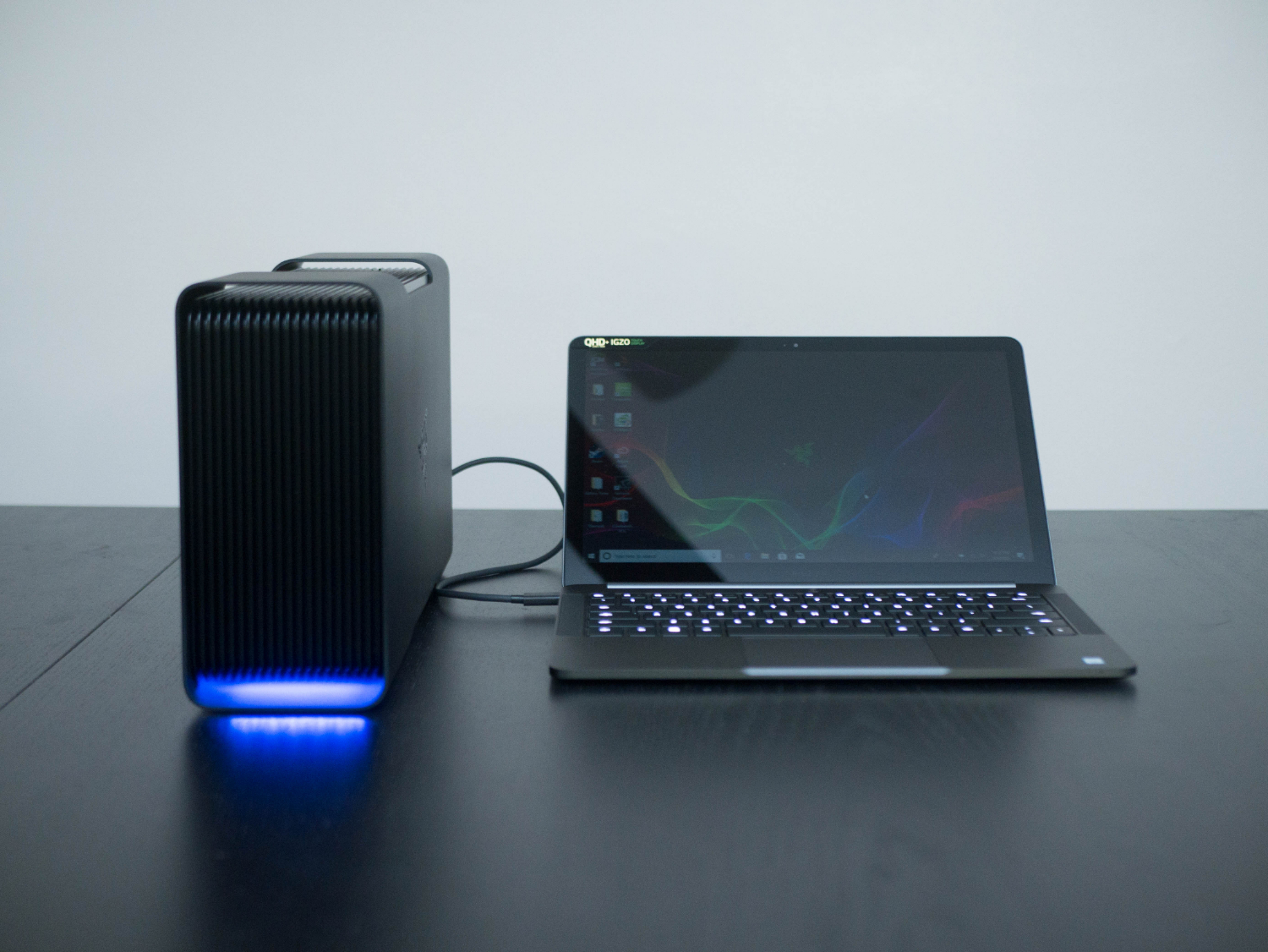I Want My USB-C! Why the Surface's Missing Port Is a Big Problem.
This week Microsoft released a pair of new computers: the Surface Pro 6 and the Surface Laptop 2. The new systems have Intel's quad-core 8th Gen processors, speedy SSDs, high-res displays and . . . a serial port that connects to your Reagan-era mouse. Ok, I'm kidding about the latter, but Microsoft is dead serious about living in the past when it refuses to offer USB Type-C ports on its latest PCs.
Microsoft might be the last major PC vendor not to offer Type-C on its high-end consumer PCs (which is especially strange, considering the Surface Book 2 and Surface Go both have that port). If you look around the industry, you'll still find some mainstream consumer and budget systems that don't support the standard, but everyone from HP to Apple offers this reversible connector for data, video and charging.
By writing off this critical port, Microsoft has left its customers disconnected from a burgeoning ecosystem of peripherals. It has also given consumers and businesses a really good reason not to buy its products. At this point, I wouldn't buy any computer that doesn't have at least a USB Type-C port, if not a Thunderbolt 3 connection, which is compatible with USB-C but also works with faster peripherals such as eGPUs. There are several reasons that everyone needs USB-C:
Universal Charging
Before Type-C, every brand of laptop had its own, proprietary connector and some brands had more than one. But with the new standard, any laptop that requires less than 100 watts of power can use interchangeable power bricks. Left your ThinkPad's AC adapter at home? No problem. You can borrow the one that came with your friend's MacBook Pro or your coworker's Dell XPS 13.
If you have an Android phone or other, non-Apple mobile device that was made in the last couple of years, it probably charges via Type-C. So you can use the same laptop power brick to charge your laptop, your phone and even your Nintendo Switch. By sticking with its own, proprietary Surface Connect port, Microsoft is forcing users to buy one of its chargers if they need a second brick.
Right now, the company charges a hefty $79 for a 65-watt charger ($57 on Amazon). You can pay the same price for a Surface Connect to Type-C dongle, which you can combine with a Type-C AC adapter to get a charger, but at that point, you're talking about spending more than $100 just to charge. No thanks.
You can buy a laptop-capable Type-C charger from a reputable brand for under $40. But swapping chargers is just the tip of the iceberg.
Get Tom's Hardware's best news and in-depth reviews, straight to your inbox.
Power Banks
No matter what kind of laptop you have, you can never have enough battery life. Considering that the Surface Pro line has always had mediocre endurance, I'm sure the new Surface Pro 6 could use a little extra juice. If it had USB Type-C, you could attach it to a third-party power bank like the Anker PowerCore Speed 20,000 PD, which offers another 20,000 mAh of power; that's a few more hours of unplugged usage.
Docking
Microsoft would love to charge you $199 for its proprietary Surface Dock, but you can find a Type-C dock for under $130. But what's a few dollars between friends? The real problem is that you can't use other devices with Microsoft's dock.
At our office, we recently started hot desking (aka hoteling), a process where many workers use different desks every day and guests can just slide into an open space and start working. With USB Type-C, you can deliver power and data to any compatible laptop, Mac or PC, over the same cable. Any business that wants to even consider doing hot desking should stay far far away from Microsoft's new Surfaces.
New Peripherals
Though most external hard drives and Flash memory drives still use USB Type-A, Type-C models are out there and they can deliver faster transfer speeds. The new USB 3.1 Gen 2 standard delivers 10 Gbps, twice the bandwidth of old-fashioned USB 3.0.
But, considering how much Microsoft charges for its computers, there's no reason that the company should go with plain, vanilla USB-C. It should offer Thunderbolt 3, which can deliver up to 40 Gbps of data over a single connection. If these devices had Thunderbolt 3, they could dock with eGPUs, which would allow them to play AAA games or do serious video editing.
Microsoft Has Its Reasons
USB Type-C isn't exactly an unproven, fly-by-night technology. This standard has been in place for four years now and it started appearing on major computers all the way back in 2015. Microsoft was late to the game, but finally put a Type-C port on the Surface Book 2, which debuted in late 2017 and on the Surface Go tablet that shipped this past summer. So what gives?
However, on the latest Surface Pro and Surface Laptop, Type-C is conspicuously absent. At the launch event, a Microsoft rep told Tom's Hardware that customers are "divided" in terms of demand (some want it and some don't) so the company's response is to offer it on some devices and not others. Say what?
It's hard to believe that a major computer manufacturer would deliberately leave off a critical port because some consumers may not want it. First of all, by eschewing Type-C, the company is asking people NOT to buy the Surface Pro. People have a choice and, if they want Type-C, they're not going to switch from a Surface Pro tablet to a $1,499 Surface Book 2. They're just going to purchase one of the many competing Windows devices that has this critical port.
Perhaps the real reason Microsoft hasn't gone with USB-C is that the Redmond software giant just doesn't want to spend the money or time to change its chassis design and incorporate an extra port. Considering how much time and effort supposedly goes into developing these products, it's hard to believe that none of the designers could figure out how to poke another hole in the aluminum or swap out the mini DisplayPort for a similarly-sized Type-C connector.
Bottom Line
While Microsoft may offer a more eloquent reason for not embracing USB-C on all of its products, there's really no excuse. For any new tablet or ultraportable laptop, Type-C charging should be standard, particularly if you're spending more than $800.
Note: As with all of our op-eds, the opinions expressed here belong to the writer alone and not Tom's Hardware as a team.
Avram Piltch is Managing Editor: Special Projects. When he's not playing with the latest gadgets at work or putting on VR helmets at trade shows, you'll find him rooting his phone, taking apart his PC, or coding plugins. With his technical knowledge and passion for testing, Avram developed many real-world benchmarks, including our laptop battery test.
-
eza Well I want a beefed-up Surface Go with a quad Core CPU and 16GB RAM!Reply
What I really want is for Sony to start making Vaios again ;-( -
felipedu1969 Really, really, do we need a USB-C? Just to connect external peripherals and USB sticks, how many of your uses that device for something more, at office I don't believe it.Reply -
jimmysmitty Short of charging I see not real need for them to have a Type-C port. It would be nice but hell even high end computer cases are barely adding them, some still don't.Reply
The adoption over to it is not 100% yet although it is moving.
The other side is that there are issues with it, as it is USB. Out Dell laptops at work for our regular users are Latitudes and recently Dell killed the dock port in favor of USB Type-C docks. We have been running into sporadic issues with them. Sometimes you plug it in and the monitors don't come up. Sometimes one monitor works and the other doesn't. We had a system that needed the latest updates to be able to get internet connectivity (something with the driver that was on there was causing our Sonicwall to block the IP from access but fixed with a new driver). There is a Thunderbolt version of the dock we have gotten for our Precision users and that works much better but they are pretty pricey ($320-$350 depending on the power size). I also don't trust third party docks as much.
However I have not seen or run into these issues with Microsoft's dock. While proprietary is a PITA in some cases it also tends to have more benefits that can outweigh the down sides. While I am not an Apple consumer and never will be their tight control on their products allow them to create a cleaner experience. Microsoft controlling the hardware and software for their charging/docking port allows them to make sure the experience is better than they could with USB Type-C because again they are at the mercy of the USB consortium and the drivers made by a third party.
It would be nice but I also think they will add it when they redesign the Surface rather than a refresh. -
spdragoo Universal charging: This is only a negative, apparently, for those who a) have some Android phones, or b) people whose friends only have those laptops/tablets that have USB-C power bricks. Note, I said "some" on the Android phones, because not all of them do. Not to mention that, if you're the kind of person that is likely to forget your laptop charger, you probably also tend to forget your phone charger. Not to mention there's a big difference between a smartphone that charges via USB-C port (since it most likely plugs into a 1A or 2.1A charger plug) & a laptop power brick (that needs a lot more wattage). 2.1A (what my wife's iPad charger provides) might be enough for many tablets, but I'm guessing it's a bit on the lean side compared to what the Surface Pro needs.Reply
Power Banks: Sorry, but there are tons of power banks out there that will work with USB-C, microUSB, & even standard USB...because they have the standardized USB ports on them. So just because your preferred power bank only works with USB-C devices doesn't mean this is a problem for the Surface Pro.
Docking: Ah, yes, because we've never in the history of computing had issues with 3rd-party devices having any sorts of problems working with devices. And just because it doesn't work with USB-C docks doesn't mean the Surface Pro wouldn't work with, say, USB-equipped docks. The important thing here, though, is that your office's "hoteling" is not representative of even 90% of the offices out there...& the particular docks you use in your office may be the ones picked by your office, but isn't the only option available for those that want to "hotel" at work.
New Peripherals: Sorry, but even though it's been around for a couple of years now, the number of peripherals that use Thunderbolt 3, let alone USB-C, is still woefully low compared to those that are compatible with USB3.0 (or even 2.0 or earlier). And the vast majority of users (power or otherwise) do not replace their peripherals simply because "the newest, latest, greatest" tech has been released. They might do so if they need extra capability provided by the new standard, or if they're forced to because the system it was hooked up to has now been replaced & has no option for that kind of connection...but just replacing because "ooh, this new tech is so cool!!" is a good way to spend yourself out of business.
Microsoft Has Its Reasons: USB-C is not a critical feature, at least not for everyone out there. There may be some that consider it critical...but there are many more who do not.
But, luckily, this is just an op-ed (i.e. opinion) piece...just like the recent article telling us to "just buy" the RTX cards... -
Reynod My surface 1 has a standard USB Port on it ... frankly that is the one thing that is good about it.Reply
Mind you ... it still goes ... tough little mongrel ... even the detachable KB.
Accessibility is the key for any device moving forward ... -
TThorlord USB-C currently has a power delivery limitation of 100W (20v, 5A), Many high-powered laptops need more than that.Reply
It's not an issue for the current Surface lineup (Other than the 15" Surface Book 2, which can use over 100w) but I bring it up solely because manufacturers would run into this limitation if they ever tried to make USB-C the main way to charge the laptop.
They should still include a USB-C port though (Like the mentioned Surface Book 2 has) as having the option for USB-C for charging even if it's not enough juice for some devices is absolutely better than nothing. -
s1mon7 Frankly, I absolutely don't think it's a problem, and surely not a "BIG problem".Reply
At the time when the most commonly available cables can fry you port (the only port in case of the Surface series) including it would be irresponsible of Microsoft. Not to mention other issues, such as seeing your phone charge your laptop or attempting to throw the screen. I've had it happen all, and that's with a Galaxy S8, which is as safe of a USB-C device as you can get.
That's only one point I was trying to make. The other one is that there's hardly anything that you might need USB-C for. The peripherals, after so many years, are still in an overwhelming amount of cases using USB-A. Even flash drives and power banks are USB-A, and they sometimes also have a USB-C port. The standard, after so many years, does not seem to be becoming an actual standard. The devices you are most likely to connect to that single USB port are incomparably more likely to be USB-A. Now and in the upcoming years.
Just earlier this year I build a computer with a Z370 board. The board has 8 USB ports. None of them are 3.1 or type C. I predict I will never need such port for the lifetime of that computer, so maybe until 2021-2022. -
Baumy15 So microsoft are telling their users what they want? Australia did that with the NBN and it backfired BIGTIME!Reply -
rhysiam I'm with Avram on this one. My SP3 died on me a few weeks back and the SP6 launching with the same port configuration was a key factor in my decision to order a second hand SP3, rather than springing for the newer model.Reply
It's not so much about the charging for me (though that would be nice), but rather the opportunity to include a second USB port. The single USB port is a serious limitation with the Surface Pro line, and always has been IMHO.
MS had a great opportunity here to swap the Mini-DP port for a USB-C port. They could keep the proprietary Surface Connect port (the magnetic connectors and backwards compatibility with previous gen docks does offer tangible benefits). But USB-C instead of Mini-DP is a straight upgrade. You'd get a second a USB port when you want, which is pretty often in my case. Plus, it's not like the Mini-Displayport connector would be greatly missed. I move around offices, lecture theatres and presentation spaces pretty regularly and when I want to connect my Surface to an external display or projector setup, I expect to have to supply my own cable 100% of the time. If MS swapped the mini-DP for USB-C, I'd just take a USB-C to HDMI (or DP) cable with me, instead of the MiniDP to HDMI cable I currently travel with. The cable cost is pretty similar.
How is USB-C not just a more versatile MiniDP port? It would have been a straight upgrade IMHO.
Maybe, maybe you could argue that a Thunderbolt enabled USB-C port was too much to ask for. But honestly, these are high end, expensive, "pro" devices. I'm with Avram. Late 2018 release with one USB port and Mini-DP is just lazy IMHO. -
sizzling Ok different level of device but I just replaced my Surface 3 with the Surface Go and the loss of USB-A is the only downside. I’ve now had to buy a few USB-A to USB-C adapters and add one to my key ring as most things I want to use are not USB-C.Reply
However on a Pro device it should have both.
